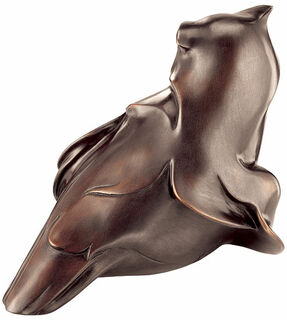Sculpture "Owl with Young Bird", bronze
Sculpture "Owl with Young Bird", bronze
Quick info
limited, 299 copies | numbered | signed | bronze | patinated | polished | size 20 x 14.5 x 12 cm | weight 2 kg
Detailed description
Sculpture "Owl with Young Bird", bronze
Jochen Bauer's Bird of Wisdom convinces with its modern emphasis on clear lines and forms and yet is a delicate symbol of motherly care.
Sculpture made of fine bronze, cast by hand using the Lost-Wax-Process. Elaborately patinated by hand and partially polished. Limited edition of 299 copies, numbered and signed. Size 20 x 14.5 x 12 cm, weight 2 kg.
About Jochen Bauer
Born in 1951, sculptor and painter
The sculptor Jochen Bauer, born in 1951 in Coburg, Germany, was one of Germany's leading porcelain modellers for almost 30 years. From 1999 until today he has devoted himself to sculpture and painting as a freelance artist.
With his outstanding technique, he is regarded in the industry as one of the great talents whenever it comes to translating a concept into the third dimension. In his own work, he prefers naturalistic motifs, which he implements with perfect craftsmanship and a good eye for flowing (body-)shapes and expressive poses.
"The source of my creative activity is nature, the examination of ecological contexts..."
An alloy of copper with other metals (especially with tin) used since ancient times.
When casting bronze, the artist usually applies the lost-wax technique which is dating back more than 5000 years. It's the best, but also the most complex method of producing sculptures.
First, the artist forms a model of his sculpture. It is embedded in a liquid silicone rubber mass. Once the material has solidified, the model is cut out. The liquid wax is poured into the negative mould. After cooling down, the wax cast is removed from the mould, provided with sprues and dipped into ceramic mass. The ceramic mass is hardened in a kiln, whereby the wax flows out (lost mould).
Now we finally have the negative form, into which the 1400° C hot molten bronze is poured. After the bronze had cooled down, the ceramic shell is broken off and the sculpture is revealed.
Now the sprues are removed, the surfaces are polished, patinated and numbered by the artist himself or, to his specifications, by a specialist. Thus, each casting becomes an original work.
For lower-quality bronze castings, the sand casting method is often used which, however, does not achieve the results of a more complex lost-wax technique in terms of surface characteristics and quality.
Term for an art object (sculpture, installation), which is produced in multiple copies in a limited and numbered edition according to the artist‘s will.
Artist's multiples have been called the most accessible and affordable art on the market.
A plastic work of sculptural art made of wood, stone, ivory, bronze or other metals.
While sculptures from wood, ivory or stone are made directly from the block of material, in bronze casting a working model is prepared at first. Usually, it is made of clay or other easily mouldable materials.
The prime time of sculpture after the Greek and Roman antiquity was the Renaissance. Impressionism gave a new impulse to the sculptural arts. Contemporary artists such as Jorg Immendorf, Andora, and Markus Lupertz also enriched sculptures with outstanding works.












